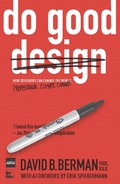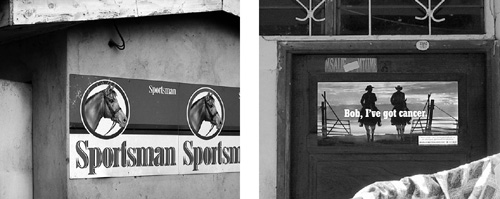“We can’t solve problems by using the same kind of thinking we used when we created them.” | ||
| --ALBERT EINSTEIN (1879-1955) | ||
IF YOU’RE STILL READING, you’re likely already convinced that there are numerous ethical arguments for change. Now let’s explore why the timing has never been better – or more profitable – for responsible design.

When I started my design firm over 20 years ago, if you hadn’t gone to art school or seen the inside of a type shop, it’s unlikely you’d know what a font was. When I was a kid we had favorite colors. Today, not only do both my daughter and her friends have favorite typefaces, but my mother also knows what small caps and kerning are!
Just 15 years ago, it was unheard of to see cover stories in BusinessWeek, Time, and Report on Business on design, branding and identity. With design successes like the iPod and iPhone revitalizing Apple to the point of now being worth more than IBM, big business is realizing that design is, as Kodak CEO George Fisher puts it, an integral part of business strategy.[108]


Brand equity is showing up on the balance sheets of an increasing number of corporations. Designers and what they do have never been as valued as they are today, and that gives us the opportunity (as well as the duty) to responsibly use design to make a difference.

In 1998, Pantone® color chips were only known to designers. In 2008, they are the branded theme of designer cell phones in this Japanese store.
Ethical design is also profitable design: both client and designer make more money in the long term by making a promise to customers that is later fulfilled. Sell me a car by implying that it will get me more sex, by draping half-naked models over the hood in advertising photos, and you may increase your chance of selling one car. Ultimately, however, the reality will fall short of the promise, and next time I’ll shop for a different brand.
Sell me a Mercury coupe based upon the fable of the car as a toy that I can drive on mythical open roads where I won’t see another vehicle for hours, and I will certainly be disappointed.
Granted, you could sell someone a car for its status symbol value alone. However, cars are tools, not toys. More Americans have died in car crashes in the last 100 years than in all the foreign wars the U.S. has ever fought.[109]
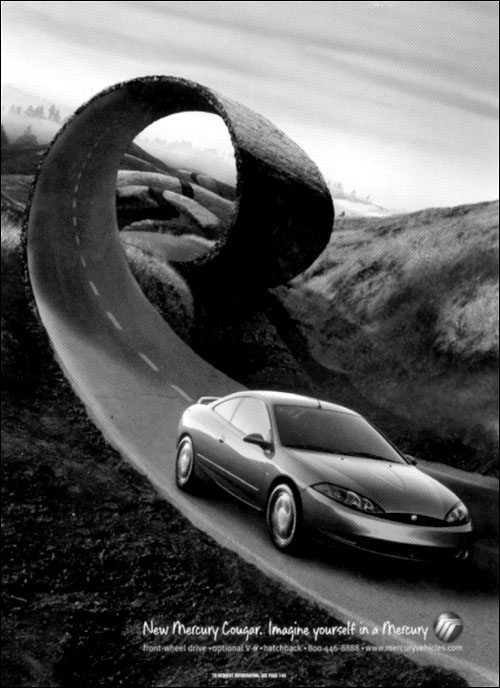
Ethical design and promotion can be the most efficient marketing. Getting excellent products into the hands of consumers with tangible needs, through clear communication that delights and informs, is profitable, sustainable business. Meanwhile, misleading promotion can injure brands (and people) by creating waste and disappointment.
History demonstrates this truth on a massive scale. Starting in the 1970s, while U.S. car manufacturers were busy pitching autos based upon trite annual fashion changes, the Japanese were busy designing better cars. They replaced Henry Ford’s legendary production line philosophy of driving down costs with the continuous improvement philosophy of American W. Edwards Deming, which stresses improving quality by producing small quantities, testing, then tweaking the design. Within 15 years, the Japanese industry had shifted gears, from producing cars that Americans laughed at to ones Americans preferred. The result: today, Toyota and Honda share the four top positions on the U.S. best-selling car chart.[110] More telling is that Americans vote for their higher appreciation of design with their wallets, forking over an additional $3,000[111] or more for that better quality. In other words, Americans have internalized the value of better lasting design. Over the next few years, they will pay a premium again, to have their next car be a hybrid (again led by the Japanese), which is good business for our fragile planet.
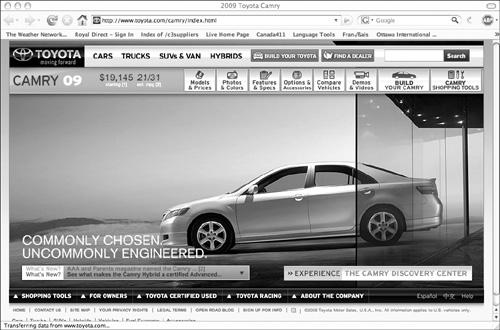
Any auto industry marketing maven would agree that the greatest profit is to be made not by selling you one new car, but by selling you many cars throughout your lifetime. And so rather than convince you to buy one Toyota, they are wise to teach you how to recognize the quality that the Toyota brand consistently represents. If you learn that Toyotas tend to fit your needs, you learn to trust the Toyota brand. Now in order for this to work, you do need a product that has reliably excellent properties, and is appropriate for a given buyer. Consider two ways of selling an excellent car:
APPROACH #1: “Now here’s a car for you: clever features, great fuel efficiency, high safety rating. See how much care we’ve put into the design, feel how comfortable and delightful it is to operate, imagine how safe your family will be. If this is what you’re looking for in a car, now and for a long time to come, you should buy our Canyonero because we offer what you need at a price that is sensible for you.” If I buy that car I’ll very likely be satisfied, not just for a month, but for many years; I will become fiercely loyal and perhaps buy a new Canyonero every decade for the rest of my life.

“You know you’re not the first”: this used car ad earns the checkered flag for how many ways it offends
APPROACH #2: “Buy this car and you’ll become really rich. Buy this car and people will think you are smarter than you really are. Buy this car and you’ll have lots more sex.” We know how the human brain is hardwired: by showing me a picture of a car with a sexy celebrity I enjoy, or showing the car doing fun things that cars aren’t really intended to do, you can successfully play on my desire to imagine a future where I am more than I am. You are trying to sell me a fantasy, not a car. And you may well trick me into buying something that isn’t right for me. You may even have an excellent product, but it’s now in the hands of the wrong person. Will I buy another Canyonero in 10 years? Probably not. Because at some level, I will feel dissatisfied; maybe even realize I’ve been lied to, ripped off. And the next time – no matter how well your next model would fit my needs – I’ll look elsewhere, fueled with both reason and resentment. However, if you’d been straight with me, then either now or at some future appropriate time, you could have fulfilled lasting needs and have earned my lasting brand loyalty. And I’d tell my friends about that too.
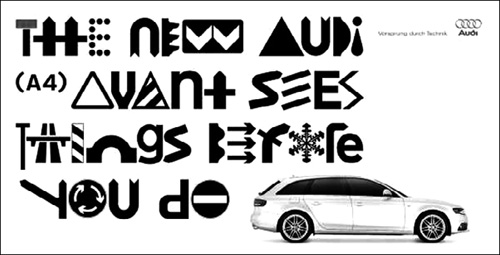
Selling good features can be fun too
So, we can design a better car, and we can promote its merits to the appropriate buyer. However, with a product like the cigarette, that has little to no merit – no foreign country is going to come up with a “better” cigarette. Rather, the competition for cigarettes (and for other products that simply hurt us) is a well-educated public. This is exactly what designers have the power to help create. We have the power to communicate accurate, clear, useful messages that reach and inform millions.
The more educated a society becomes, the more Big Tobacco scrambles to light up markets that are either less educated about the hazards of their product or less protected from their predatory communication strategies. Hence the huge marketing focus on the Developing World, where ad campaigns relentlessly push tactics no longer tolerated in the West.
Imagine again a society’s potential where the largest signs, the cleverest ads, the most prominent messages promote healthy behaviors. Isn’t that the society we want our children to grow up in? We can choose it now.
In July 2000, a Florida jury told the tobacco industry to pay an award of $145 billion, the largest punitive damages award ever handed down anywhere. The previous world record was a $5 billion fine against ExxonMobil for the Exxon Valdez oil spill that devastated the Pacific ecosystem off the Alaska coast in 1989.
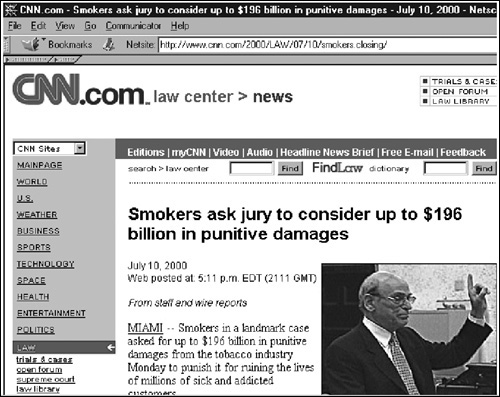
Neither settlement lasted intact upon appeal.[112] Nonetheless, if you had wandered into the smoke-filled Virginia boardrooms of Big Tobacco 25 years ago, suggesting that someone start worrying about such future penalties, you would have been laughed out of the state.
What degree of responsibility do designers have for the offenses that led to that court decision in Florida? Aren’t the ad and package designers just as guilty of promoting destructive behaviors? They had access to the strategies that laid out the mechanisms of nicotine addiction and tricking people into trying to smoke.

Coca-Cola red fills in for Big Tobacco brown
So how long until the agencies, the art directors, and the designers get sued along with their tobacco company clients? Designers who dream up visual lies cannot hide behind the creative brief documents aimed at shortening children’s lives for profit, claiming they “were just following orders.” It wasn’t an acceptable excuse for Eichmann, nor for Milošević, and it’s not acceptable for designers either.
Social responsibility is good for design because it will protect the profession. Consider what happened to the accounting profession in the late 1990s or the financial industry in 2008: they allowed their professional conduct to slip below society’s level of what’s acceptable, and the damage to both continues to resonate. A profession that fails to offer ethical solutions will correctly be accused of telling lies in order to succeed. Hey, designers, were you lying then or are you lying now?
Much of my proudest work has been for Canada’s Tobacco Control Programme, and when speaking outside my country, I’ve shocked many audiences with samples of the graphics adorning Canadian cigarette packaging since 2000.

Canada’s pioneering visual warnings required by law, including instructions on how to quit inside every pack, have been featured in Manhattan’s Museum of Modern Art
In Canada, our tobacco industry is mandated to display pictures of diseased lungs, graphs of mortality rates, and other vivid demonstrations of what the consumer is lighting into, on every pack. This packaging law, combined with Canada’s strict limitations on tobacco advertising, is one of the world’s most impressive examples of a society saying enough is enough! The common sense underlying Canada’s controls on tobacco marketing has been borne out by public health studies demonstrating a correlating drop in smoking six years after the packaging laws came into force.[113]
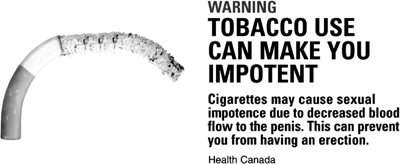
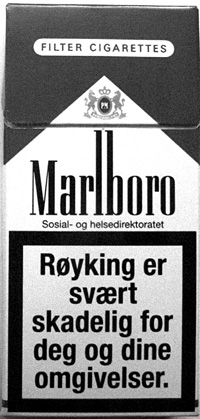
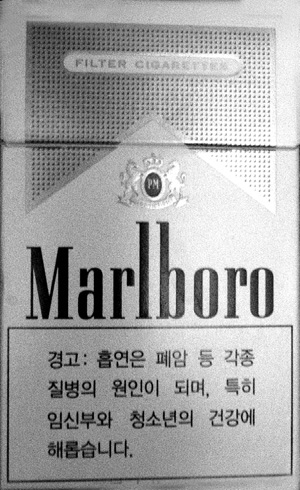
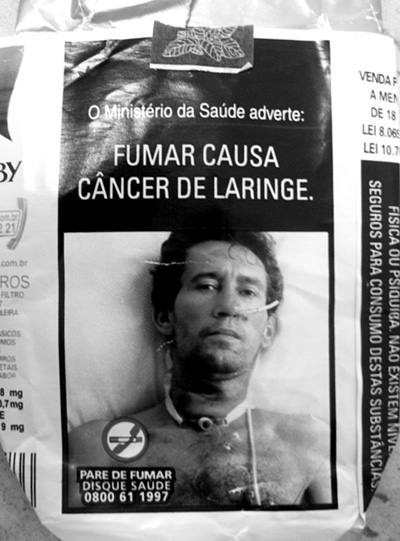
Considered preposterous a decade earlier, the Canadian model that put strong, graphic antismoking warnings right in our faces has been adopted by countries around the world. And similar type or graphics now appear on cigarette packages throughout the EU, Brazil, and Australia. Mean-while, in New York City, tobacco advertising, by law, must be at least 100 yards (90 meters) from schools.


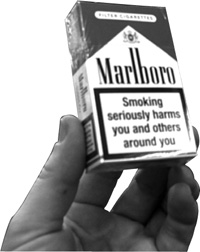
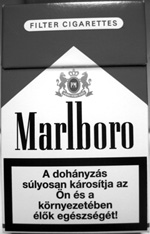
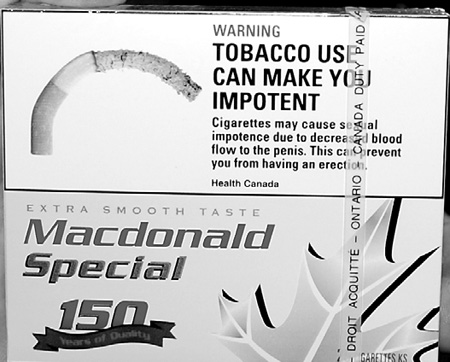
In 2008, the display of cigarettes in stores was banned in entire provinces and cities in Canada and Australia. Why? Because the arrays of cigarette packages were effectively point-of-purchase displays for smoking, to be restricted like any other advertisement.
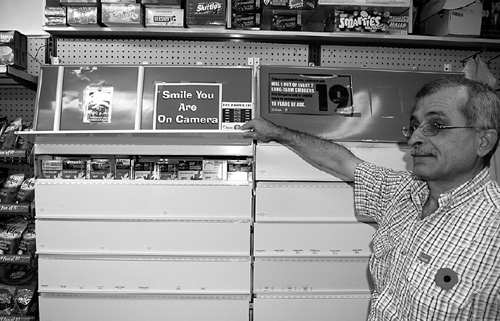
Donna’s Express covers up its cigarettes, in compliance with Ontario law
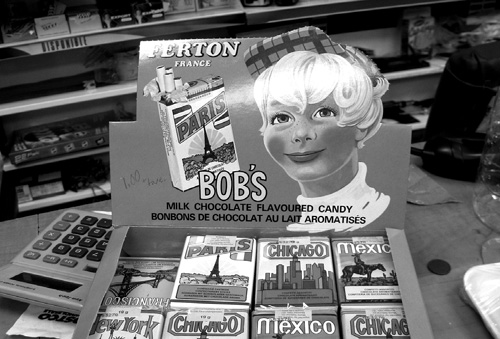
Chocolate cigarettes for sale to children, in a Montréal store that can no longer display real cigarettes
Of course, clever tobacco marketers will keep trying to burn holes in legislation. In Europe, when Camel cigarette billboard ads were banned, Camel brand matches appeared. Armed with their keen understanding of how branding matters more than actual product, in the 1990s tobacco shillers dreamed up Camel concerts, Camel watches, Camel lighters, Camel comic books, Camel matches, and Camel travel expeditions. In Germany, Camel boots actually peaked at 7.5 percent of the market share for all men’s shoe sales![114] By 2001, the EU banned all non-point-of-sale tobacco advertising, including “brand stretching” (such as sponsoring sporting and cultural events). The bizarre spinoff: teams of tobacco industry lawyers hired to prove their clients’ incompetence as businesspeople, desperately trying to prove that the advertising investment has no effect on tobacco sales.

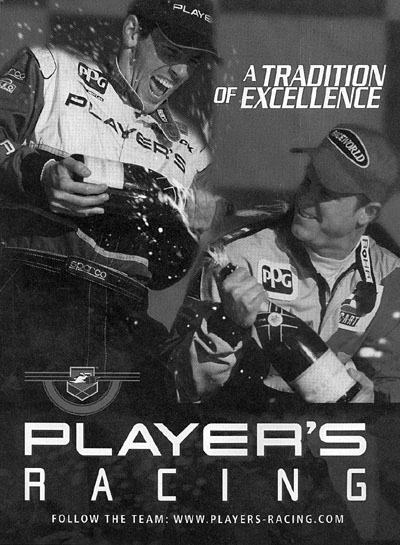
Tobacco sponsorship like this is now banned in Canada

Son of Marlboro Man?
Meanwhile, in lands that lack limits on advertising, the battle for the lungs of our daughters and sons rages on.
The Indian Tobacco Company (ITC), India’s leading cigarette maker, is working with the government. Recognizing that continuing to promote smoking to a billion people is not in the national interest, yet not wanting to dismantle an industry, the plan is to perform a healthier version of brand stretching. Rather than apply the cigarette brand to other products as a way of sneakily promoting cigarettes, ITC is earnestly investigating how to apply the successful brand to other products. They would leave the cigarette business behind while retaining the equity value of the brand. ITC is shifting India’s most valuable cigarette brand, Wills Navy Cut, to non-tobacco products. It is also redeploying its production and packaging plants to transform the leading Gold Flake brand to greeting cards, and its supply chain into 2,000 greeting card outlets. The company will thus use its brand equity and packaging expertise to celebrate birthdays, rather than eliminate them.
Are we unfairly limiting freedom of speech when we limit visual messages that convince people to damage themselves and others? Are we unfairly limiting tobacco companies’ right to earn a buck? Legislating controls on the advertising of addictive products such as tobacco is as reasonable as choosing to protect society by legislating speed limits, seat belts, and daytime running lights on our roads.
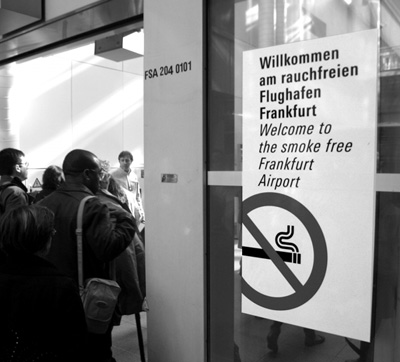
Smoke-free airport, Frankfurt
The epic battle against Big Tobacco is being won, city by city, country by country. You cannot even smoke in the street in Tokyo’s Akihabara electronics district. Over 140 colleges in the United States have banned smoking outright. And as with Ralph Nader’s victories with car safety in the 1960s, we won’t be going back. Meanwhile, the model of scrutiny the tobacco industry has been brought under is being extended to other threats, such as child obesity, with the intelligent and caring mixture of individual, industry, and government action required to solve such issues.

The battle rages above our streets: Russia banned hard liquor billboard and TV spots in 2002, so “Stolichnaya story” is a photo contest, but Muscovites know they’re selling vodka. Thomas Rymer explains: “If you can’t understand what a commercial is about, that means it’s vodka.”
And it turns out that we can design a better cigarette after all: in Canada, aside from providing a slow legal method of suicide, cigarettes also cause 4,000 house fires and over $50 million in property damage a year.[115] Or they did until Canada became the first country in the world to insist upon “fire-safe” cigarettes. It took over 70 years for the cigarette companies to agree (and why did we need their agreement?) to a 1932 self-extinguishing cigarette design that burns slower (and thus at a cooler, safer temperature). Fire-safe cigarettes have been the law in New York state since 2004, and 37 other U.S. states have since followed suit.[116]
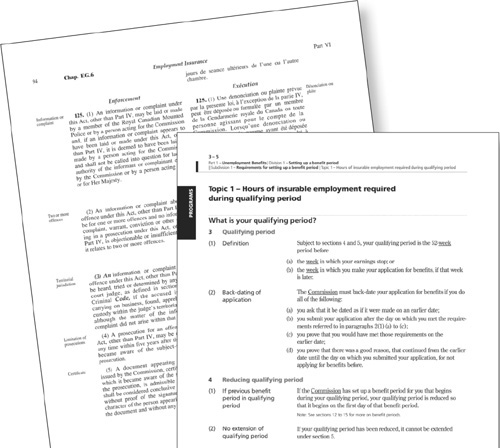
Canadian legislation, before clear design experiment
After
Perhaps the greatest reason for hope is the evidence of rising visual literacy. Across the world, you can get sued for lying with words. However we are increasingly evolving into a visually literate society. As much as designers often wince when they see how desktop publishing and the Internet have enabled almost everyone to publish a document that painfully contains too many typefaces, that same immersion is creating a society with the nascent vocabulary to define and legislate against lying with pictures.
Making law more accessible is a communications challenge that can enhance the quality of a democracy: imagine a land where everyone has equal access to the law. In working with Canada’s Department of Justice on a project to rewrite and redesign the laws of Canada in clear language and clear design, we envisioned legislation that everyone can access on paper or online – and understand without a lawyer’s help. While working on this, we found a remarkable example of the truth in Edward Tufte’s[117] assertion that to visualize information is to reveal new information. We decided to try including a flow chart within the Employment Insurance legislation to help explain and index the law. The process of developing the flowchart caused us to uncover a branch in the logic that the lawmakers had neglected to cover! It was a puzzle, because a tenet of the project was that the meaning of the law could not be altered by the application of clear language and clear design.
A perfect storm of increasing visual literacy, rising awareness, and collaborative technology makes this a perfect time to embrace design as a solution. And though MIT’s Nicholas Negroponte, chair of One Laptop Per Child, reminds us that for over four billion humans the Internet remains a rumor,[118] change is on the move, and hope has never been more actionable... or more likely.
